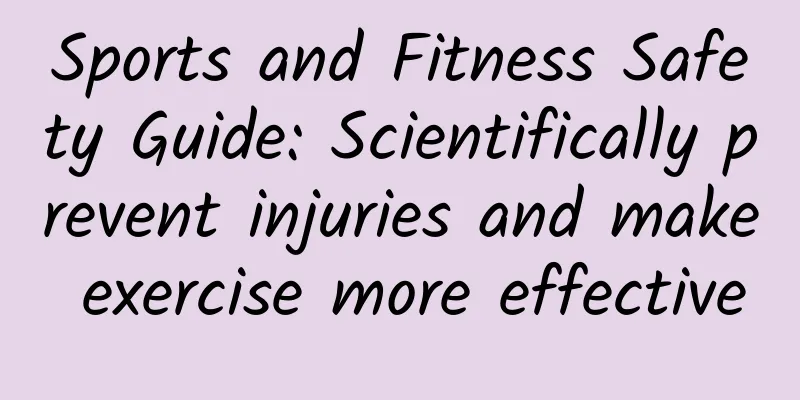Sports and Fitness Safety Guide: Scientifically prevent injuries and make exercise more effective

|
(The full text is about 2,000 words and the reading time is 6 minutes) When a 32-year-old running enthusiast terminated his training plan due to a ruptured Achilles tendon, and when a gym novice suffered a herniated disc due to incorrect squat posture, these real cases revealed that sports injuries often come from a lack of safety awareness. The essence of sports and fitness is to pursue health, but ignoring safety guidelines may backfire. 1. Before exercise: build a safety line of defense Medical assessment first: The American College of Sports Medicine recommends that people with BMI ≥ 30, hypertension, and sedentary people should undergo sports risk screening. It is recommended to assess cardiopulmonary function through a step test (measure heart rate recovery speed after walking up and down 30cm steps for 3 minutes). Project matching principle: People with a basal metabolic rate (BMR) lower than 1200kcal/day should start with low-intensity exercise (such as swimming and elliptical machines); patients with joint degeneration are recommended to exercise in water, which can reduce joint pressure by 90%. Scientific warm-up program: Use dynamic stretching to activate muscle chains, such as lunge rotation, which can simultaneously improve hip joint range of motion (ROM) and core temperature. Studies have shown that 10 minutes of dynamic warm-up can reduce the risk of muscle strain by 62%. 2. During exercise: accurately control risks Movement pattern optimization: Keeping the angle between the tibia and the parallel line of the torso ≤30 degrees during squats can reduce the shear force of the knee joint by 45%; during deadlifts, the barbell trajectory should pass vertically through the middle of the foot to avoid lumbar compensation. Intensity monitoring strategy: Use the heart rate reserve method (HRR = maximum heart rate - resting heart rate) × target intensity % resting heart rate, and control the moderate intensity in the 50-70% HRR range. If exercise tremor (involuntary muscle shaking) occurs, the load should be reduced immediately. Fatigue warning system: If the salivary α-amylase concentration exceeds 50 kU/L, it indicates that the sympathetic nerves are overexcited and the training should be terminated in time. If it takes more than 15 seconds to complete 8 standard push-ups in a row, it indicates that the muscle endurance has reached the critical point. 3. After exercise: system recovery project Neuromuscular reboot: PNF stretching (proprioceptive neuromuscular facilitation) can improve flexibility by 20% through the "contract-relax" technique (10 seconds of isometric contraction followed by 30 seconds of stretching). Soaking in cold water (10-15°C) for 10 minutes can reduce delayed onset muscle soreness (DOMS) by 37%. Nutritional time-space intervention: Intake of whey protein (0.3g/kg) and fast sugar (1.2g/kg) 30 minutes after exercise can increase the rate of muscle glycogen resynthesis by 300%. Electrolyte supplementation should follow a sodium-potassium ratio of 2:1, and 400-600ml of fluid should be supplemented for every 1L of sweat lost. Recovery monitoring indicators: If the morning pulse continues to rise by more than 5bpm or the HRV (heart rate variability) is 20% lower than the baseline value, it indicates insufficient recovery and the training plan should be adjusted. Conclusion: Sports safety is a precise system engineering that runs through "energy metabolism-biomechanics-neural regulation". From the FITT-VP principle (frequency, intensity, time, type, total amount, and progression) of the National Strength and Conditioning Association (NSCA) to the biomechanical model of sports injuries, scientific fitness requires the establishment of a three-dimensional protection system. Only when we internalize safety guidelines into sports instincts can we truly maximize health benefits. |
<<: "Pulled elbow": an inexplicable pain in young children!
>>: Don’t leave a cut lemon overnight! What does “leaving overnight” really mean?
Recommend
Can I eat longan during menstruation?
We all know that women lose a lot of blood during...
What are the dangers of long-term absence of menstruation?
For women, menstruation will occur at the beginni...
What material is good for women's underwear?
Everyone must wear underwear, which can block har...
I have a slight pain in my stomach at 5 months pregnant
Women should not relax in any aspect during every...
What to do if pregnant women have acne on their backs
Many pregnant women will experience acne on their...
What are the common types of rhinitis? How to identify them?
When it comes to rhinitis, many people think of a...
Why do I have breast pain before my period?
Many women experience breast pain before each men...
What are the symptoms if the fetus stops developing?
Fetal arrest means that the fetus suddenly stops ...
Is it easier to get pregnant during menstruation?
It is not easy to get pregnant by having sex duri...
What is the date of Xiaoxue in 2021? What is the meaning of Xiaoxue solar term?
The Minor Snow solar term is the second solar ter...
What's the matter with the fleshy lump on my labia?
The growth of fleshy bumps on the labia is a prob...
What can’t you do during early pregnancy?
There are many taboos during pregnancy, especiall...
What is the information about Sanya Bay? Where should I sit when flying around Nanhai Guanyin in Sanya?
Sanya has a long history. As early as the Qin Shi...
Why do pregnant women need to spend 100 days
Pregnant women are relatively weak after giving b...









